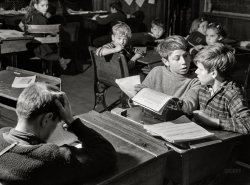
MAY CONTAIN NUTS

Search Shorpy
SHORPY ART

Framed or unframed, desk size to sofa size, printed by us in Arizona and Alabama since 2007. Explore now.
Join and Share
Ad-Free Shorpy
Shorpy is funded by you. Patreon contributors get an ad-free experience.
Learn more.

Recent comments
- Baldwin 62303
- Baldwin VO-1000
- Cold
- No expense spared
- Tough Guys
- Lost in Toyland
- And without gloves
- If I were a blindfolded time traveler
- Smoke Consumer Also Cooks
- Oh that stove!
- Possibly still there?
- What?!?
- $100 Reward
- Freeze Frame
- Texas Flyer wanted
- Just a Year Too Soon
- WWII -- Replacing men with women at the railroad crossing.
- Yes, Icing
- You kids drive me nuts!
- NOT An Easy Job
- I wonder
- Just add window boxes
- Icing Platform?
- Indiana Harbor Belt abides
- Freezing haze
- Corrections (for those who care)
- C&NW at Nelson
- Fallen Flags
- A dangerous job made worse
- Water Stop
Member Photos
The Shorpy
Print Emporium
Print Emporium
Search Shorpy
Search results -- 30 results per page
- South by Southwest: 1943
- ... train." View full size. 4x5 Kodachrome transparency by Jack Delano.
Melrose v. McCurdy Love it when some obscure little place on the ... Posted by Dave - 08/10/2012 - 7:50pm -
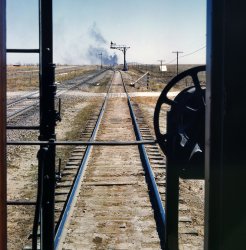
- Mrs. Sandman: 1943
- ... Illinois, ordnance plant." 4x5 Kodachrome transparency by Jack Delano for the Office of War Information. View full size.
Sand Dumb ... Posted by Dave - 08/30/2012 - 3:30pm -
![Mrs. Sandman: 1943 April 1943. "Mrs. Thelma Cuvage, working in the sand house at the Chicago & North Western R.R. roundhouse at Clinton, Iowa. Her job is to see that sand is sifted and cleaned for use in the locomotives. Mrs. Cuvage's husband works as a guard at the Savanna, Illinois, ordnance plant." 4x5 Kodachrome transparency by Jack Delano for the Office of War Information. View full size.
SandDumb question, but what was the sand for?
Re: SandIt was used for traction in icy weather, released from a hopper on the locomotive onto the tracks.
Mrs SandmanSand is still used by many railroads icy weather or not, for traction, especially on uphill grades.
SandThe sand was and in many places still is very important. It had to be dried so it wouldn't freeze into chunks in the engines. Also needed to be clean and sifted so it would feed through the lines properly. Fed by air jets through tubes and dropped on the rail just in front of the driving wheels.
A long commute...The Cuvages both had fairly long commutes for a time when everything that an automobile requires was rationed. According to Google Maps, the towns of Savanna, Illinois and Clinton, Iowa are 21 miles apart, which means even if they lived in the countryside between the two they commuted a combined 42 miles a day, which I imagine was a lot of gas when you drove a 1930's pickup or sedan.
[Drive a car? Most wartime workers would have taken the bus or interurban. Or streetcar if they lived close enough. - Dave]
CommuteYou're forgetting that the railroad was still running passenger service in those days. Mrs. Cuvage as a railroad employee might well have been issued a courtesy pass for commuting...
(The Gallery, Kodachromes, Jack Delano, Railroads)](https://www.shorpy.com/files/images/1a34796u.thumbnail.jpg)
- The Information Room: 1943
- ... at the Union Station, Chicago." Medium-format negative by Jack Delano for the Office of War Information. View full size.
Room with a ... Posted by Dave - 12/27/2013 - 12:55pm -
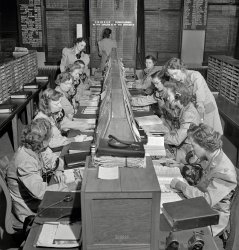
- Herman Delp: 1940
- ... Farmers Co-op Market." Medium-format safety negative by Jack Delano. View full size.
Sweet Baby James I've been trying to place ... Posted by Dave - 08/11/2009 - 3:37am -
![Herman Delp: 1940 August 1940. Du Bois, Pennsylvania. "Farmer and wife at the Tri-County Farmers Co-op Market." Medium-format safety negative by Jack Delano. View full size.
Sweet Baby JamesI've been trying to place that face. It's been driving me nuts! James Taylor of course.
What the --What's his hat hanging on -- a nail driven into the back of his head? Kinda creepy!
[Farmer Delp isn't wearing a hat. - Dave]
Thanks for the laughsThanks, rgraham and fanhead for the funniest posts about one of the funniest shots I've seen on Shorpy! (Especially the "punchdrunk" quip)
Chillin'Coats and jackets in August? Well, yeah. The summer of 1940 seems to have been pretty cold, according to the Penn State records. For example, the low temperature on August 21 was a mere 46 degrees.
Now we have the answer to the question nobody asked. It's what I do.
I live in the South; I have dreams of 46 degrees.
The mister and missusThere's something ominous and creepy about this photograph. I suppose it's only the dominating shadows and the expressions of defiance (mister) and mild fear (missus). He looks tough and snarling - sort of a pugnacious Sean Penn type. She -- well I'm sure she was very nice and I hope to heaven that more flattering pictures of her were taken in her lifetime. We've all been captured at an inopportune moment.
Written on their facesLet's par-tay! Well, maybe not.
The DelpsI'd say he wears the pants in this family. He looks like he takes no guff, and she looks punch drunk. Other than that, all I can say is WOW, what a shot.
Invasion of the Body SnatchersWhatever you do, do NOT bring those pods home, or you'll end up like them!
(The Gallery, Jack Delano, Stores & Markets)](https://www.shorpy.com/files/images/8c02967u.thumbnail.jpg)
- Cut Rate Drugs: 1941
- ... on the main street." Medium format acetate negative by Jack Delano for the Farm Security Administration. View full size.
Is this ... Posted by Dave - 04/14/2021 - 12:12pm -
![Cut Rate Drugs: 1941 September 1941. "South Royalton, Vermont. Storefronts on the main street." Medium format acetate negative by Jack Delano for the Farm Security Administration. View full size.
Is this the spot?
The brickwork is redone and the building has been renamed, but this could be it.
[It is the same spot but a newer, shorter, building. - Dave]
Belt Drive Drill?Taking a peek through the window of Dr. Dearing's office window I spy something that looks suspiciously like a belt drive dental drill. Those of us of a certain age may not want to be reminded of slow speed drills and a lack of novocaine. I was always fascinated by the spinning belts.
Money Well SpentI've shopped in the last store on the right. I believe the cashier's name is Patreon.
I wonder if that's MartinWatching over his block.
De rigueurOf course Dr. D.E. Dearing was a Dentist. Visiting his office was no doubt de-de-de-delightful.
'59The Martin Block (constructed in 1887 upon the ashes of a fire that destroyed the village's commercial core) was replaced by the Crawford Block in 1959 - the same year that Dr. Dana Emerson Dearing (Tufts College of Dentistry Class of 1904) was laid to rest in the main South Royalton cemetery, a decade after the death of his wife May. Dr. Dearing had been an officer in numerous agricultural or natural associations in the White River valley. (The presence of an IOOF hall, next to the Crawford Block in part of the original 1887 commercial redevelopment that remains standing, makes this an official Shorpy photo.)
Zoot SuiterJust down from the SHORPY What Not Store sits local Zoot Suiter awaiting opening of the cleaners to get his pegged pants pressed.
Reminiscent ofwhat Edward Hopper was intrigued with.
(The Gallery, Jack Delano, Small Towns, Stores & Markets)](https://www.shorpy.com/files/images/SHORPY-8c07143a.thumbnail.jpg)
- Smokescream: 1942
- ... the mask back when he was peeling onions .) Photo by Jack Delano, Office of War Information. View full size.
Flora That's a ... Posted by Dave - 06/27/2013 - 12:37am -
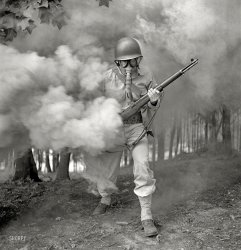
- Sportsmen's Tavern: 1940
- ... rainy day in Colchester, Connecticut." Acetate negative by Jack Delano. View full size.
Who's in retreat? Maybe our history ... Posted by Dave - 01/12/2019 - 10:39am -
![Sportsmen's Tavern: 1940 November 1940. "Having a beer in 'Art's Sportsmen's Tavern' on a rainy day in Colchester, Connecticut." Acetate negative by Jack Delano. View full size.
Who's in retreat?Maybe our history buffs can tell us who is retreating in Athens in November of 1940. Can't read the first word in the Daily News headline.
[ITALIANS. - Dave]
Windows to the PastI found this site comparing past images of Art's with modern views. In the Google Street View it appears to be a pub:
Dude on the left with Jimmy Durante appendage.I'll just bet he honks a symphony whiles he's sleeping.
Election Day?Any ideas on the button the gentlemen man on the left is wearing on his trousers? Something to do with voting/election day perhaps?
[It's a hunting permit. The campaign button is on his shirt. - Dave]
Put that in your pipe and smoke itAnyone that young smoking a pipe today certainly wouldn't have tobacco in it.
Greco-Italian WarThe Greco-Italian War of 1940 was a part of World War II. Fascist Italy invaded Greece from Albania on October 28, 1940. They were repulsed by the Greek Army back beyond the border at some places by November 5. The Italians never got as far as Athens. I think that's where the news was coming from: the Greek command HQ.
Human felicity"There is nothing which has yet been contrived by man, by which so much happiness is produced as by a good tavern or inn." --Samuel Johnson
Which is even truer on a rainy winter's day.
I'll be there in a bitJust let me lace up my boots. Shouldn't take more than 30 minutes.
Arthur Charles Zupnik (1909-1999)Owner (for twenty years) of Art's Sportsmen's Tavern, Justice of the Peace, and charter member of the Colchester Fishing Club. https://www.courant.com/news/connecticut/hc-xpm-1999-01-27-9901270586-st...
I want to be thereSomething about this photo really pulls at me. I want to sit with these guys and just listen to the conversation. I also want a pair of boots like that young man has.
Election DayCampaign button looks more like Wendell Willkie than FDR - certainly not WC Fields!
[It's FDR. - Dave]
(The Gallery, Eateries & Bars, Jack Delano)](https://www.shorpy.com/files/images/SHORPY-8c03777a.thumbnail.jpg)
- Tableau Vivant: 1941
- ... farm house, Carroll County, Georgia." Acetate negative by Jack Delano. View full size.
Statistics Just wondering if anyone has ... Posted by Dave - 11/23/2018 - 11:52am -
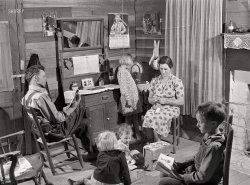
- Up on the Roof: 1941
- ... View full size. Medium format Kodachrome transparency by Jack Delano for the Farm Security Administration. Who can identify the building? ... Posted by Dave - 03/05/2019 - 3:10pm -
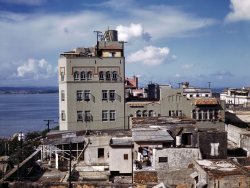
- Proviso Yard: 1942
- ... rear." View full size. 4x5 Kodachrome transparency by Jack Delano, Office of War Information.
How it was. Cold, icy, and dangerous. ... Posted by Dave - 08/10/2012 - 7:50pm -
![Proviso Yard: 1942 December 1942. Proviso Yard, Chicago & North Western R.R. "A train, or 'cut,' being pushed out of a receiving yard toward the hump. A brakeman rides each train to signal the engineer in the locomotive at the rear." View full size. 4x5 Kodachrome transparency by Jack Delano, Office of War Information.
How it was.Cold, icy, and dangerous.
DOT placard?Look at the white diamonds on the tanker, looks a LOT like a DOT placard.
I didn't realize they already had the DOT hazardous materials placards back in 1942? I was under the impression that the placard system wasn't started until the early 60's.
[There was no DOT in the 1940s -- the Department of Transportation was established in 1966. The current system of hazmat placards, hinged in the middle with a four-digit number on them, goes back to the Hazardous Materials Transportation Act of 1975. In the 1940s, tank cars full of gasoline might have a DANGEROUS placard (below), with skull and crossbones. - Dave]
(The Gallery, Kodachromes, Chicago, Jack Delano, Railroads)](https://www.shorpy.com/files/images/1a34632u1.thumbnail.jpg)
- Midland: 1941
- ... steel town of Midland, Pennsylvania." Acetate negative by Jack Delano for the Farm Security Administration. View full size.
... Posted by Dave - 12/26/2018 - 1:18pm -
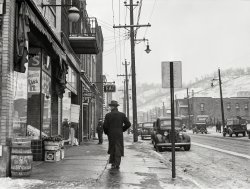
- Jackhammer Time: 1942
- ... Dam -- Tennessee Valley Authority drillers." Photo by Jack Delano for the Office of War Information. View full size.
Can you hear ... Posted by Dave - 01/14/2017 - 8:11pm -
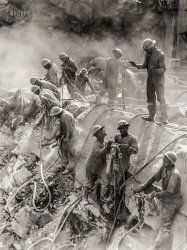
- Spa Treatment: 1942
- ... Yard." View full size. 4x5 Kodachrome transparency by Jack Delano for the Office of War Information.
Insulated Boxcars At first I ... Posted by Dave - 08/10/2012 - 5:38pm -
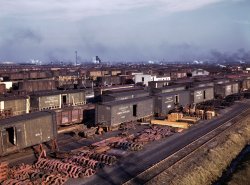
- Heart of Darkness: 1943
- ... about to leave the Santa Fe railyard for the West Coast." Jack Delano, Office of War Information. View full size.
Absolutely ... Posted by Dave - 08/16/2014 - 12:17pm -
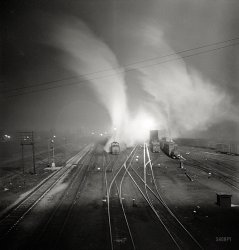
- Colonial Esso: 1940
- ... Norwich, Connecticut." Medium format acetate negative by Jack Delano for the Farm Security Administration. View full size.
...
(The Gallery, Cars, Trucks, Buses, Gas Stations, Jack Delano) ... Posted by Dave - 07/23/2021 - 10:53pm -
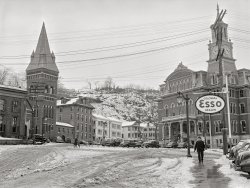
- Jumbo-Lube: 1943
- ... 1943. View full size. 4x5 Kodachrome transparency by Jack Delano for the Office of War Information.
Just love this pict Shows the ... Posted by Dave - 08/04/2012 - 11:05pm -
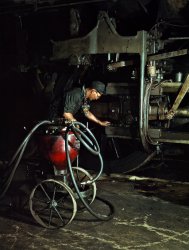
- Derby From Ansonia: 1940
- ... Ansonia side of the Naugatuck River." Acetate negative by Jack Delano for the Farm Security Administration. View full size.
... Posted by Dave - 06/16/2021 - 10:50am -
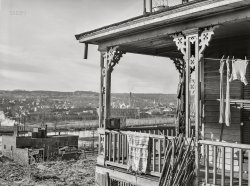
- Stem: 1940
- ... "Crossroads garage and store." 35mm nitrate negative by Jack Delano for the Resettlement Administration. View full size.
Ubiquitous ... Posted by Dave - 09/20/2009 - 6:49pm -
![Stem: 1940 May 1940. Stem, North Carolina. "Crossroads garage and store." 35mm nitrate negative by Jack Delano for the Resettlement Administration. View full size.
Ubiquitous beverageIn a surprisingly large number of these old shots there is a Coca-Cola sign to be seen. Probably one of the oldest and most enduring brands in the world.
A few guesses about what's there now.It's surprisingly easy to make a guess about which intersection this is on Google Maps; there's only one cross-intersection in the whole town of Stem that has any buildings near it -- the intersection of Main/Brogden and Sanders. There's even reportedly still a gas station there, though it's now a BP station with convenience store, and set back rather a lot farther from the road.
I can't really tell if the current gas station is on the same corner of the intersection as the old one or not, though. Based on the houses in the background, I'm tempted to say it's not, but that's just a guess.
About the time this photo was taken, my dad was six years old and growing up in a town only a little larger and maybe three dozen miles south of here.
Was there any other way?Noticed the sign to drink Coke "in bottles." Does anyone know if there was any other way back then? Don't think they had cans.
[Out of a glass at a soda fountain. Which, once upon a time, was how most people consumed their soft drinks. - Dave]
Across the StreetI believe the BP is across Main St. from the "Coca Cola" building. I have a friend who lives in Stem and this intersection is instantly recognizable, even though the area has grown up a bit over seven decades. I'll check out the lay of the land in the next few weeks.
Wonderfully gloomy!There's something about the leaden sky and soggy streets that make me love this photo! Maybe I've been living in Southern California, Land of Eternal Sunshine (and earthquakes), too long.
Gas n GoI really like the idea of the gas pumps being close to the road. This is the true idea of "in and out." How can you get any quicker of pumping the gas and you're practically on the road itself.
What's there nowThe gas station is still there, and the BP is behind where the "Coca Cola" building was.
View Larger Map
(The Gallery, Gas Stations, Jack Delano)](https://www.shorpy.com/files/images/8a33820u.thumbnail.jpg)
- Chicago and North Western: 1942
- ... 1942. View full size. 4x5 Kodachrome transparency by Jack Delano.
RR yd I think it's Proviso YD and if you look in the background ... Posted by Dave - 08/05/2012 - 9:30am -
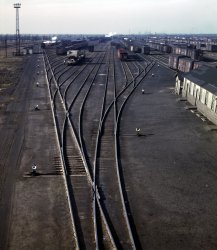
- Amarillo From Above: 1943
- ... view. Santa Fe R.R. trip." 4x5 Kodachrome transparency by Jack Delano for the OWI. View full size.
(The Gallery, Kodachromes, Jack ... Posted by Dave - 08/05/2012 - 6:37pm -

- Factory Houses: 1941
- ... Bedford, Massachusetts." 35mm Kodachrome transparency by Jack Delano for the OWI. View full size.
Beautiful! The muted colors make ... Posted by Dave - 09/09/2011 - 7:19pm -
![Factory Houses: 1941 January 1941. "Near the waterfront. New Bedford, Massachusetts." 35mm Kodachrome transparency by Jack Delano for the OWI. View full size.
Beautiful!The muted colors make it look like an Edward Hopper painting.
Circular ThingsI used to see those circular things in the background from time to time in St. Louis. What are they for?
[Gas holders. - Dave]
(The Gallery, Industry & Public Works, Jack Delano)](https://www.shorpy.com/files/images/1a33866u1.thumbnail.jpg)
- Other Voices: 1941
- ... now occupied by a Negro family." Medium format negative by Jack Delano. View full size.
Arsenic Oreos When I was 12, my family lived ... Posted by Dave - 02/16/2019 - 10:49pm -
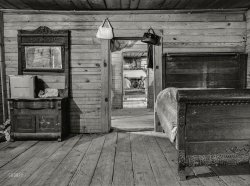
- Millie Williams: 1943
- ... Topeka, and Santa Fe depot." Medium-format negative by Jack Delano, Office of War Information. View full size.
Buttoned What ... Posted by Dave - 07/23/2011 - 6:07pm -
![Millie Williams: 1943 March 1943. Kansas City, Missouri. "Mildred Williams, one of several women freight handlers employed at the Atchison, Topeka, and Santa Fe depot." Medium-format negative by Jack Delano, Office of War Information. View full size.
ButtonedWhat does the button on her coat say?
["404." - Dave]
Rough JobThis is a service known as LCL(Less than Carload Freight), a business practice discontinued by the railroads by the late 1960's. Single boxcars were loaded with freight from several different shippers all sending to the vicinity of a certain area, and the cars were then unloaded at centers like this one, the freight sorted and then put on trucks to the final destinations. This service was very labor intensive and therefore unprofitable; railroads lost money on it even during the war years. These days rail customers have no choice but to ship in bulk, one car to a customer.
All I can say is that she must have been one hell of a tough woman, working probably 48 hours a week or more dragging freight off those cars. The items handled could have been anything, and most were probably heavy, like those solid steel pieces on the cart to her right.
BackbreakerMy dad tells the story of when he was in high school (around 1943) of helping my great-uncle unload a freight car full of red brick that he was building a house with.
It had to be unloaded in one afternoon. Dad is 83 now, and says that was the most bone tired he ever was. He says pulling slabs in a sawmill was a close second, though.
Muscles of steelShe would be one tough woman. Nobody had better try to mug her on her way home. She would just lift them off the ground, toss them into a corner and beat the stuffing out of them!
Dave, thanks for showing women in non-traditional roles from way back when.
DickiesI'm betting these are actually men's jeans Mildred is wearing. Very stiff and uncomfortable. Check out the safety pin holding her sweater closed.
Youths of today have no idea how physically hard their grandparents & great-grandparents worked.
Freight coutureMildred has coveralls on over her street clothes. See left leg and waistband. Just love this site. Father-in-law was with ATSF for 40 years an this is the way he dressed.
Action shotThe simple composition of this photo is strong and dramatic. Notice how the "V" lines of the freight-car roofs direct the eye to the subject of the photo, Miss Mildred with her hand-truck.
The open sky overhead could be seen to represent escape, freedom, or even heaven, but Miss Mildred, caught in this photo, is forever earthbound, toiling along in the tunnel between the train cars to this very day.
I doubt if the photographer thought about all that when he snapped the photo. He just looked through the viewfinder with his photographer's eye and thought, "That looks good."
Modern times.I last worked on a LTL freight dock in the 80s and we were still using the style of two-wheeler in the photo then. They are clumsy things to use when facing the "right" way and the way Millie is using one even more clumsy.
Once loaded correctly, you'd be surprised how easy you can wheel a crate around like the fellow on the right is doing though.
There are several "Mildred Williams" of the appropriate age (88-95) listed in the KC phone book. If this one is still around and one of those, let's hope she Googles her name someday and arrives "here" for a nice surprise.
That's a heavy load.If memory serves, the type of hand-truck Ms. Williams is pulling was called a stevedore, and was named for the cargo loaders on ships docks. I used to use one back in the 70's for moving 55 gallon drums. It must have weighed 100 pounds by itself, and although it could be easily balanced, there was still a lot of weight to by pulled. Couple that with the fact that those wheels are solid steel, and you've got the makings of some stiff muscles by days end. Today they are made of formed aluminum with inflatable tires and weigh 1/10th what they did. Today, her partner would be guiding an electric pallet jack. or driving a fork lift.
Millie is beautifulAfter all the critiques of women's attributes that I've seen in these comments, I'd just like to say that I believe Millie was a woman to be reckoned with, and given the advantages of education and wealth would surely have surpassed them all.
Stowe Building, Kansas CityThat's the Stowe Building next to her shoulder.
(The Gallery, Jack Delano, Kansas City MO, Railroads)](https://www.shorpy.com/files/images/8d26529u.thumbnail.jpg)
- Calumet Park: 1943
- ... Ill. View full size. 4x5 Kodachrome transparency by Jack Delano.
Absolutely beautiful What a great picture!! This is going to my ... Posted by Dave - 08/09/2012 - 12:33pm -
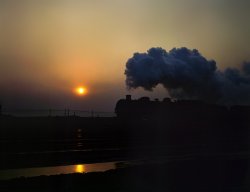
- Son of John: 1940
- ... the automotive discussion begin! 35mm nitrate negative by Jack Delano. View full size.
Winter Trouper! My Father-inlaw was a rural ... Posted by Dave - 12/27/2012 - 9:01am -
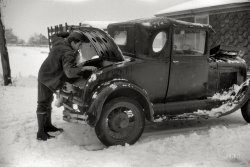
- Proviso Yard, Chicago: 1942
- ... View full size. 4x5 Kodachrome transparency by Jack Delano.
Railyard Technically this railyard is not in Chicago. The ... Posted by Dave - 07/30/2012 - 10:00pm -
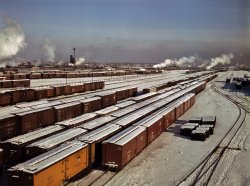
- More Mystic: 1940
- ... Morgan house, last seen here . 35mm Kodachrome by Jack Delano for the Farm Security Administration. View full size.
Well, the ... Posted by Dave - 01/16/2019 - 10:38pm -
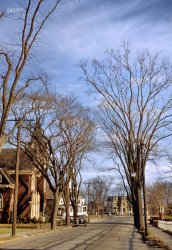
- No Sit: 1940
- ... County, North Carolina." Medium format negative by Jack Delano. View full size.
Nuclear wood stove Interesting how the air ... Posted by Dave - 03/30/2019 - 5:16pm -
![No Sit: 1940 May 1940. "Interior of poolroom and general store. Stem, Granville County, North Carolina." Medium format negative by Jack Delano. View full size.
Nuclear wood stoveInteresting how the air control vent on the front of the stove looks like the radioactive symbol.
Oh dearI like to fantasize that there was a time in American history -- long before cell phones, perhaps -- when folks were better read and more carefully educated, and the poor apostrophe did not suffer the blatant misuse and ignorant abuse that it does today. I see that I was wrong. *sigh*
Starts with PHe looks like trouble.
Beer IDI'd say Esslinger's Little Man Ale is a solid bet for the cone top.
The Good old daysEverything appears to be filthy, all the time.
ManyThat's a grocer's plural on tables.
The pool table's ... edge.
BeerBottle of Budweiser is visible by the pool table to the right of the crossed knee. Below the knee on the floor looks like a cone top beer can, brand not fully visible. Esslinger’s would be a guess, though they were in Philly.
Esslinger's Little Man Aleis indeed the Cone Top can seen on the floor. A quart can to boot. With "Delicious Esslinger's Recipes" on the side panel for Welsh Rarebit, Cole slaw and Ale Flip (whatever that is). https://www.worthpoint.com/worthopedia/esslingers-little-man-ale-32-oz-q...
That gal in the Uncle Sam getup!Would love to see the whole image of that gal in the Uncle Sam costume behind the stove pipe, and to read her message to us!
[She's in the comments of the previous post of this pool hall. - Dave]
(For the record, if my folks had heard about me peering into the windows of the pool hall in our little town - where beer was consumed - they would have removed at least the outer layer of my hide! I never EVER went in there but I learned to play pool later!)
Esslinger's Cone TopDespite the fact that earlier I submitted a comment that expressed my doubt that the cone top can on the floor held beer, I am now convinced that it is, in fact, a can of Esslinger's. A Google search reveals that Esslinger's produced quart-sized cone tops, and all that writing on the side was actually recipes.
Half a day so far ...And at least a couple to go. I'm not a beer drinker, but the mentions in this thread of different types of beer cans led to me looking online for info on the various types.
Wow.
I had no idea that folks collected old beer cans or that there were so many fascinating variations. Fascinating and fun to read.
Shorpy.com is the top website for generating wonderful research rabbit holes and I love every one of them!
THANKS, SHORPY!
(The Gallery, Jack Delano, Small Towns, Stores & Markets)](https://www.shorpy.com/files/images/SHORPY-8c02571a.thumbnail.jpg)
- Night Shift: 1941
- ... in New Bedford, Massachusetts." Medium format negative by Jack Delano. View full size.
OMG As much as I like to think I have a ... Posted by Dave - 12/28/2017 - 8:45pm -
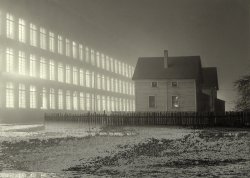
- Creative Differences: 1940
- ... Christmas for Tom." Medium format acetate negative by Jack Delano for the Farm Security Administration. View full size.
... Posted by Dave - 07/22/2021 - 5:00pm -
